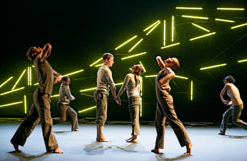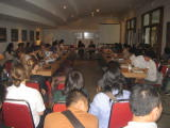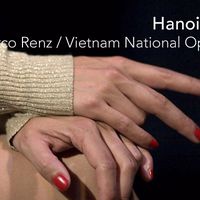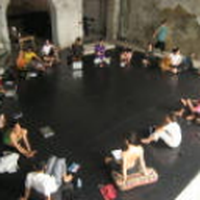Regional Dance Summit, Jakarta August 2009

 The Regional Dance Summit that took place in Jakarta last August 2009, was organised by Goethe-Institut Jakarta, Indonesia, and consisted of a varied programme; a presentation of the tanzconneXions website, a dance exhibition, lectures and discussions, public performances and audience talks and workshops.
The Regional Dance Summit that took place in Jakarta last August 2009, was organised by Goethe-Institut Jakarta, Indonesia, and consisted of a varied programme; a presentation of the tanzconneXions website, a dance exhibition, lectures and discussions, public performances and audience talks and workshops.Sasiwimon Wongjarin, Project Officer Cultural Exchange, was there to report for culture360.org.
The Asia-Europe Foundation (ASEF) Cultural Exchange (CE) Department has identified the importance of cultural mapping as one of the innovative ways to fill the cultural gap in order to better support the needs of the arts and cultural scene in Asia and Europe. Having a strategic position to connect individuals, institutions and policy-makers, ASEF believes it has a potential to initiate the development of such a mapping exercise.
The notion of cultural mapping has been recognized by UNESCO as ‘a crucial tool and technique in preserving the intangible and tangible cultural asset’. According to Tang Fu Kuen, dance critic from Singapore, the mapping will be of great ‘benefit of all protocols that most organisations have to go through.” However we will have to work closely together and identify what is needed and what will be useful.
The Dance Summit organized by Goethe was the ideal platform to exchange ideas related to mapping the dance scene of Indonesia. All participants appreciated the keynote presentations which gave insights into the history and context of the arts and cultural scene as well as the contemporary dance movement of each featured country. It was quite remarkable to realize how contemporary Asian dance struggled to find its identity and differed from the developments in Europe.
Sophiline Cheam Shapiro, Artistic Director of the Khmer Arts Centre presented her choreographic work which had a great sense of Cambodian-ness. In fact, Cambodian contemporary dance still took much reference from its own Khmer traditions. Fu Kuen commented that the movement is at this stage where it would rather like to add things than reduce.
Renee Sariwulan, dance critic said, “Until now, contemporary choreography in Indonesia has heavily been influenced by traditional elements. The variety of traditions is a stimulating source to be explored. But we have to be aware that traditional society is confronted by new challenges. Artists feel the impact of the global economic crisis. They are part of a people in transition towards democracy. They are aware of information and communication technology. They are affected by environmental changes. They are confronted by terrorism, horizontal conflicts and separatism.”
Joelle Jacinto, dance critic and scholar, founder and editor-in-chief of Runthru, Phillipines said that Filipinos love music and dance, but still struggle with the concept that “dance is not valid art form” unless it is related to a traditional art form like ballet. Donna Miranda, choreographer, added that sometimes in order to ask for government funding she has to refer her work as contemporary art, not specifically dance.
Tara Tan, art journalist said in Singapore “dance is hobby not career.” Joavien Ng, choreographer found that it was very difficult to get funding from the government for her work on identity, perception and research, for example, as the country focuses more on business and marketing. Pichet Klunchun from Thailand is the only artist in his class to continue dance as a career today. He earned domestic notoriety for his efforts in contemporary Khon and participated in several intercultural performing arts programmes as a Thai representative and an international dancer-choreographer in Asia and Europe. “Thai people have to change their perception that dance can also be acceptable profession and people can earn their living while searching for the ideal,” he said.
All these voice offer a glimpse of each country’s dance scene that caught the attention of all participants and audience during the summit. It was informative and useful to have the sharing session as it led us to think about these issues.
As a tool to map this discussion, Constanze Klementz, editor of tanzconneXions presented the www.goethe.de/tanzconnexions which is still being developed.
“The idea of TanzconneXions is to create a virtual meeting space for the different dance scenes, that will contain a magazine with interviews, reports of choreographers and dance experts (partly but not limited to Goethe tours and projects). The website will include a blog, a forum, a video archive and an info-pool with portraits of choreographers and institutions from different countries."
We look forward to seeing this new interesting project come to life. Hoping it will create a platform for exchange and creation for contemporary dance in Asia.
Similar content
from - to
04 Dec 2014 - 14 Dec 2014
08 Oct 2009
from - to
14 Jan 2012 - 29 Jan 2012
posted on
14 Nov 2012
16 Mar 2011






